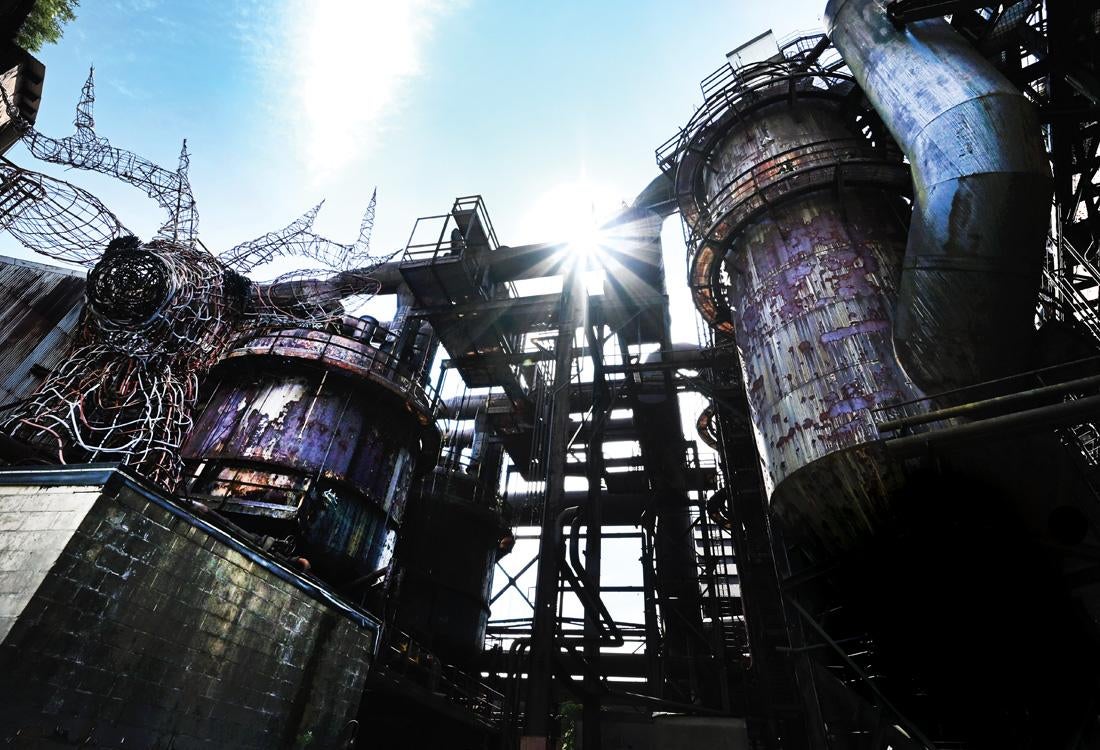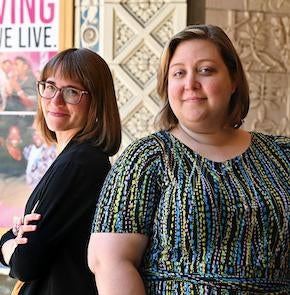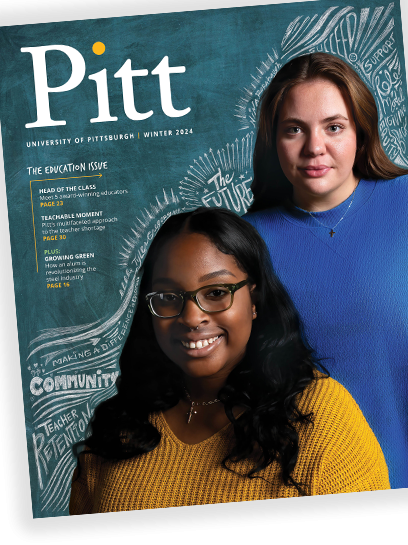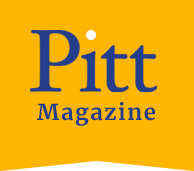
As you trudge down the hill toward Carrie, you hear the piercing sound of a mill whistle — almost time for a shift change. You take one step over the tracks that carry carts full of hot iron to the Homestead mill, where it will become steel. You suddenly realize that the cart is on its way toward you, and you jolt back, nearly missing the six-ton apparatus. This is one of multiple near-death experiences you will have this day.
You clock in … put on the wool apron that barely covers your clothes. Your job is to keep the iron flowing down the narrow track headed for collection. The iron flows from the furnace at nearly 3,000 degrees Fahrenheit. As you push it, using the narrow metal rod that weighs nearly 50 pounds, you can feel the heat singe the hair on your face.
— The Secret Pittsburgh Podcast, Season 1 Episode 1: Pittsburgh’s First Steelers
Pitt senior Maggie Ciesinski reads these words into a microphone using a solemn cadence, trying her best to convey the unrelenting heat and danger that came with working in the Carrie Blast Furnaces in the early 1900s. But no matter how detailed her description, she can’t fully recreate reality.
Because reality has changed.
At the time Ciesinski records her podcast, it’s 2023. The blast furnaces, vestiges of U.S. Steel’s sprawling Homestead Works on the shores of the Monongahela River outside Pittsburgh, haven’t fired in more than 40 years. Only two of the seven behemoths remain. The men who labored there are mostly gone now, too, taking their memories with them. The truth of this particular place, in that particular time, is lost.
But from it, something new has emerged. Nature has rendered the furnaces red and rusty. Grass and flowers grow where boots once tread. Midnight artists delight daylight visitors with graffiti murals and a massive deer head sculpture made from discarded metal.
“It’s like a tomb that’s been filled with new life,” Ciesinski says.
And that makes it ideal for a visit from the students of Secret Pittsburgh.
The class, offered through Pitt’s English department in the Kenneth P. Dietrich School of Arts and Sciences, allows students of any major to explore and interact with some of the city’s most interesting, iconic or unusual sites, like the Carrie Blast Furnaces, Homewood Cemetery and the city’s once-thriving Chinatown. Created by Teaching Associate Professor Jessica FitzPatrick and launched in 2015, it has become one of the most coveted classes on campus.
Part of the draw is that learning largely happens outside the traditional classroom. For four hours on Friday afternoons, students trek to neighborhoods many have never visited to explore places most have never heard of, arriving together via city bus. Once there, they meet with the site experts and community members who are preserving pieces of the city’s history and culture that may otherwise be forgotten.
Students use that experience and newfound knowledge, along with some foundational literature in place-based storytelling, as inspiration to write essays, compose photographs and record podcasts.
At the end of each semester, their work is uploaded to the class website, which serves as a dynamic, unconventional guidebook for anyone who also wants to explore the city’s hidden or historic gems.
“It was the best class I’ve ever taken,” says Hunter Bash, a newly minted Pitt graduate. “It didn’t feel like learning, but we were learning.”
As a native Pittsburgher, Bash figured the class would be a nostalgic romp through the city. But with the exception of Frick Park, he’d never been to any of the sites Secret Pittsburgh visited during the fall 2023 semester, and he found himself experiencing his hometown in an entirely new way.
That, says Elise Ryan, a teaching associate professor who’s led the class since 2021, is exactly the point. At each site, students meticulously peel back the layers that imbue the place with its character — the history made there, the people who lived there, the tales told there — and find their own connections.
“No place is neutral,” Ryan says. “Places shape stories and stories shape places.”
With each site visited, essay penned, photograph shot and podcast recorded, students take their own turn at shaping Pittsburgh lore. Along the way, they also acquire some fundamental skills, such as interviewing, photography, audio recording and editing, archival research, analytic and creative writing and, crucially, navigating public transit.
“I call it ‘The Magic School Bus’ class,” FitzPatrick (A&S '14G, 17G) says, referencing the children’s series where a bus delivers students to unexpected places, like the ocean floor and inside a beehive. “You never know what kind of adventure we’ll experience.”
If you ask Secret Pittsburgh students, the comparison is pretty spot on. More than one has described the class as magical, and site experts say the students’ lightbulb moments are something to behold.

Ron Baraff is the director of historic resources and facilities at Rivers of Steel, a nonprofit located in Homestead, Pennsylvania, that seeks to preserve the region’s steel industry heritage. His office is the Carrie Blast Furnaces site, so he knows well the power of place and has served as a site expert — or co-instructor, as FitzPatrick and Ryan like to call him — for Secret Pittsburgh since the beginning.
When a new class arrives, his first goal, of course, is to share the site’s history. Blast furnaces No. 6 and 7, the only ones still standing, were the mill’s workhorses, operating 24 hours a day, seven days a week for 71 years. At their peak, they could produce 1,200 tons of iron per day, used to produce the steel that built much of the nation.
But really, Baraff wants students to see what the site has become — “a place of exploration and wonderment” — and feel a part of it.
“There’s something so powerful about this site,” he says. “It’s inclusive of history, but people are also able to see themselves in it. I have yet to find someone who wasn’t impacted by this place.”
He can read it on the awestruck faces of student visitors, but he can also point to a more tangible example of that impact. Pitt grads Ryan Henderson (A&S '14) and Kirsten Paine (A&S '15G, '19G) first encountered the Carrie Blast Furnaces years ago through FitzPatrick’s work and could not shake its mystique. Today, they are Baraff’s colleagues at Rivers of Steel and have gone on to work with Secret Pittsburgh students. Henderson is a grant writer and interpretive specialist, designing programs for the public; Paine as a site management coordinator and interpretive specialist.
For FitzPatrick and Ryan, it’s imperative that Secret Pittsburgh acts as this kind of two-way street, benefitting the community as much as the students. In planning each semester, they’ve taken great care to work alongside site experts and community members to ensure a native, nuanced view of each place. Experts offer suggested readings — stories, books, poems and articles that speak to the site’s character — lead extensive tours and answer the sometimes difficult questions that arise from a site’s history and evolution. Arsenal Park in Lawrenceville, for example, was once the home of Allegheny Arsenal, which manufactured vast amounts of ammunition for the Union during the Civil War. But its productivity came at a cost. An explosion in 1862 killed 78 people, including many Irish-Catholic children who labored there.
Navigating those difficult conversations and ensuring authenticity have created space for relationships that endure long after the class concludes. Community members have popped up in The Pitt News or as guests on WPTS’s weekly interview show, Campus Roundtable. Students have returned to sites as volunteers — leading tours or providing needed elbow grease — and acted as advocates and evangelists for their favorite spots. One student became so invested in documenting Secret Pittsburgh sites that she continued shooting photos long after the class ended, creating a portfolio that helped her get into a Master of Fine Arts program.
When Abigail Burgess' dad visited from Alabama last semester, she eagerly introduced him to her favorite Secret Pittsburgh site, the Roberto Clemente Museum in Lawrenceville. Once a firehouse, the building now houses the beloved baseball player’s treasured artifacts. That layered history immediately spoke to Burgess. She was one of the lucky students who got to take the class during her first semester at Pitt (Ryan routinely holds three spots for first-year students). Even two years after completing her final project, the class influences the way she sees place, and not just in Pittsburgh.
This past summer, she traveled to England through the Dietrich School’s London Field Studies program, where she researched literary tourism and became enthralled with a cathedral that she encountered on a Shakespeare-themed walking tour. The structure had been built and rebuilt multiple times over the past four centuries, each renovation revealing new clues about its past.
“I doubt I would have had such an appreciation for its unique and visible history were it not for what I learned in Secret Pittsburgh,” Burgess says.
There are fascinating spaces with layered stories wherever you go. Secret Pittsburgh offers students a way to access them and then carve out their own place within them.
“There’s a big old world out there beyond Oakland, and it’s important that students see it and experience it, because then they’re more likely to want to be a part of it” Baraff says. “You can’t ask for any more than that.”
Ready to explore? Here are some suggestions from Secret Pittsburgh veterans.
Carrie Blast Furnaces
Swissvale and Rankin
These 92-foot behemoths once produced molten iron for the steel that built America. Today, the site has been largely reclaimed by nature and serves as a haven for sculpture and graffiti artists.
Suggested by: Everyone
The Clemente Museum
Lawrenceville
Engine House No. 25 once stored firetrucks. Now it’s home to a vast collection of the beloved baseball star’s memorabilia, including his 1961 Silver Bat Award.
Suggested by: Abigail Burgess, Secret Pittsburgh student
Frick Park
Squirrel Hill, Point Breeze and Regent Square
Industrialist Henry Clay Frick granted 151 acres to the city in 1919. Today, at 664 acres, the park boasts an environmental center, streams and miles upon miles of nature trails, including visitor favorite Nine Mile Run.
Suggested by Hunter Bash, Secret Pittsburgh student

Kelly Strayhorn Theater
East Liberty
Named for Gene Kelly and Billy Strayhorn, the former silent film theater bills itself “a home for creative experimentation, community dialogue, and collective action rooted in the liberation of Black and queer people.”
Suggested by: Elise Ryan, Secret Pittsburgh instructor
August Wilson House
Hill District
The childhood home of Pulitzer Prize-winning playwright August Wilson has been lovingly restored to its show its original character and honor Wilson’s legacy.
Suggested by: Jessica FitzPatrick, creator of Secret Pittsburgh
Color Park
South Side
This former industrial site, located along the Three Rivers Heritage Trail between the Liberty and 10th Street bridges, was once an eyesore. Thanks to artist and former Pittsburgh Steeler Baron Batch, it’s now a place where graffiti is both legal and welcome.
Suggested by: Jessica FitzPatrick



